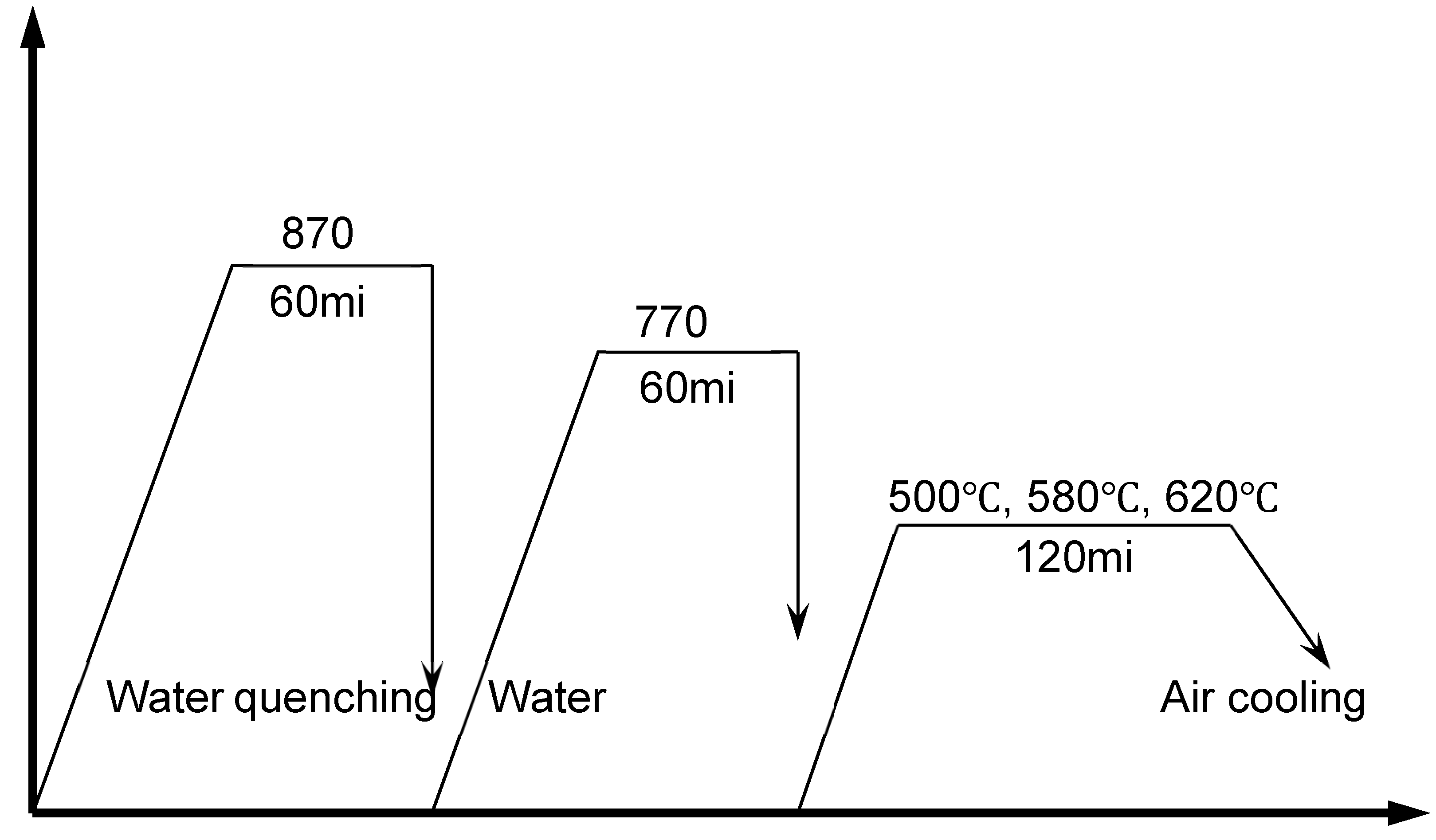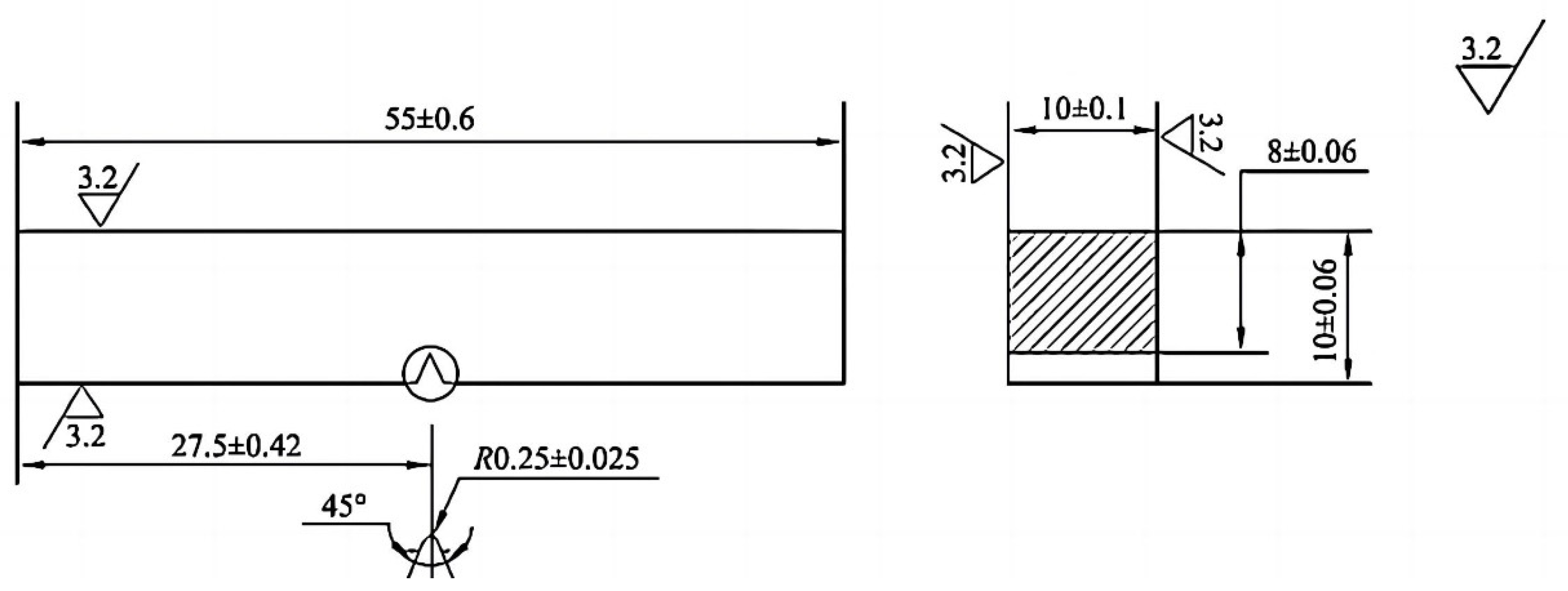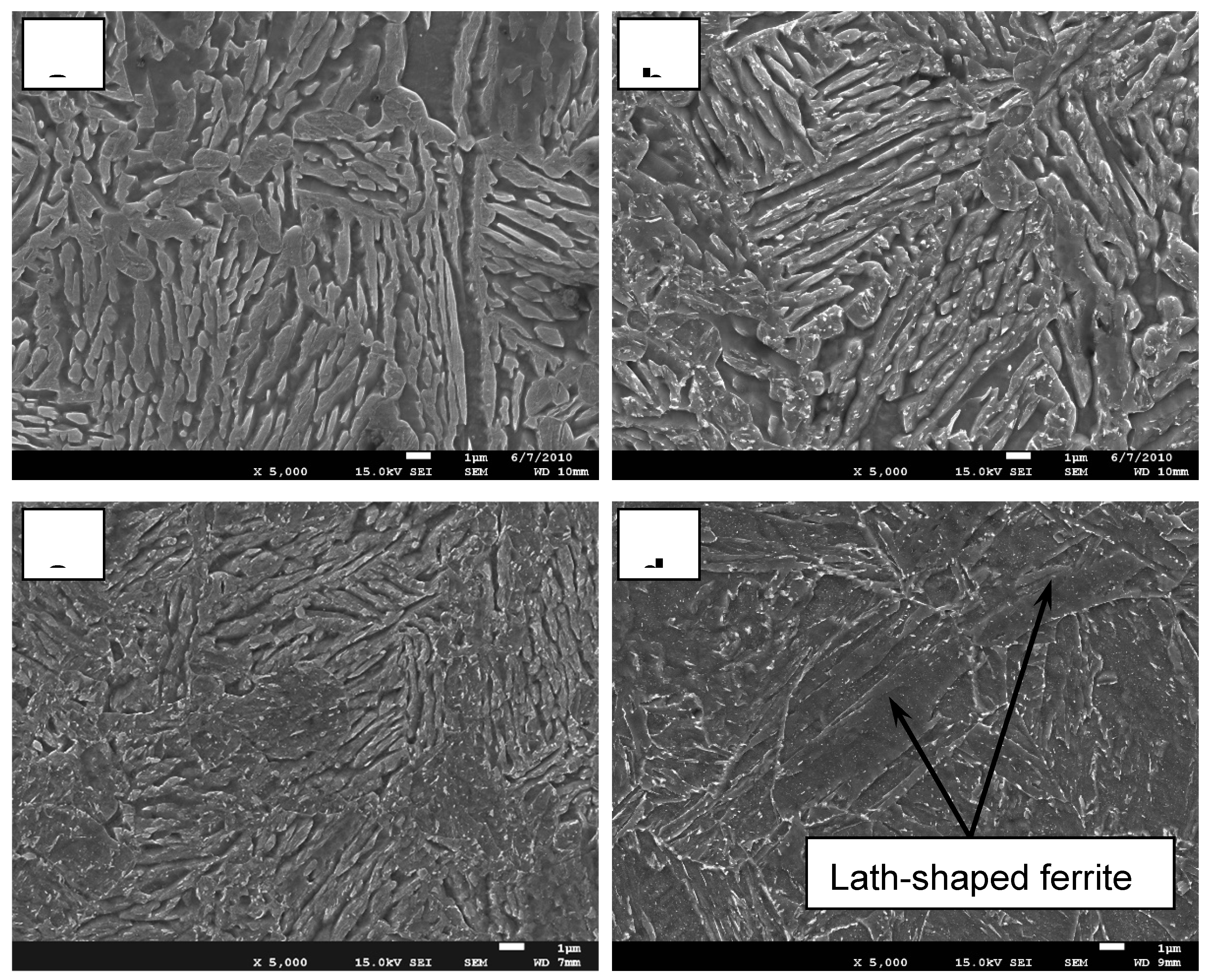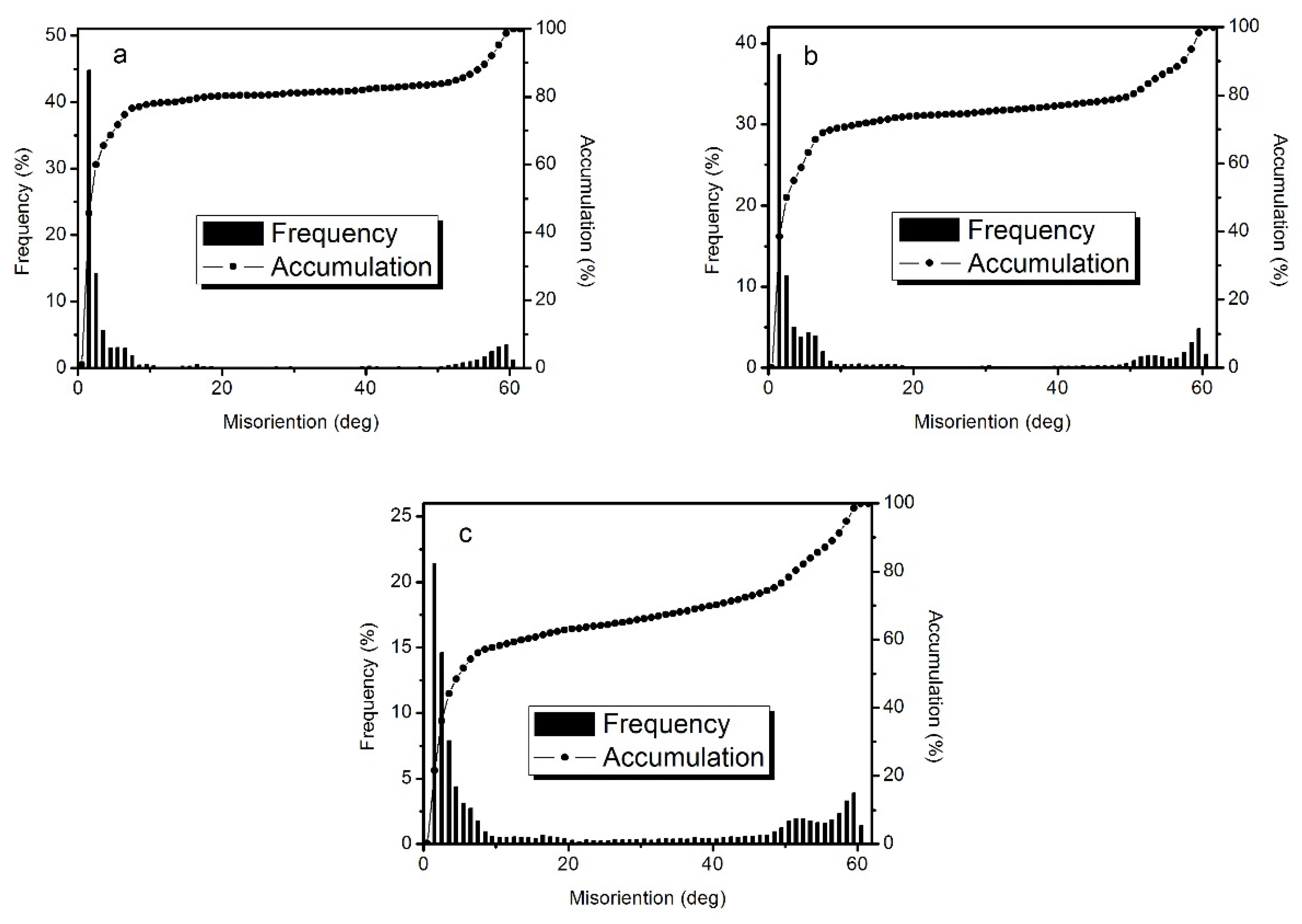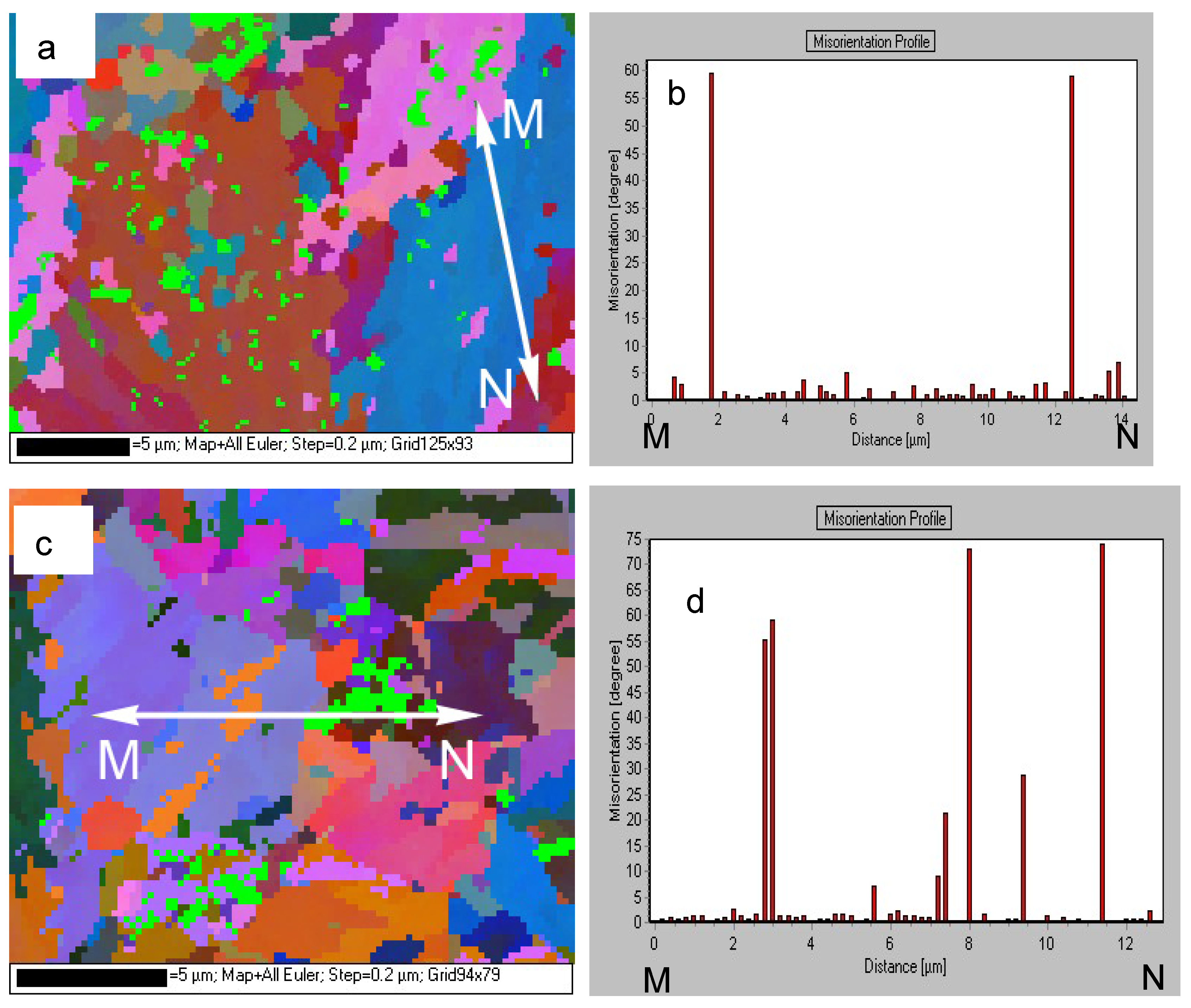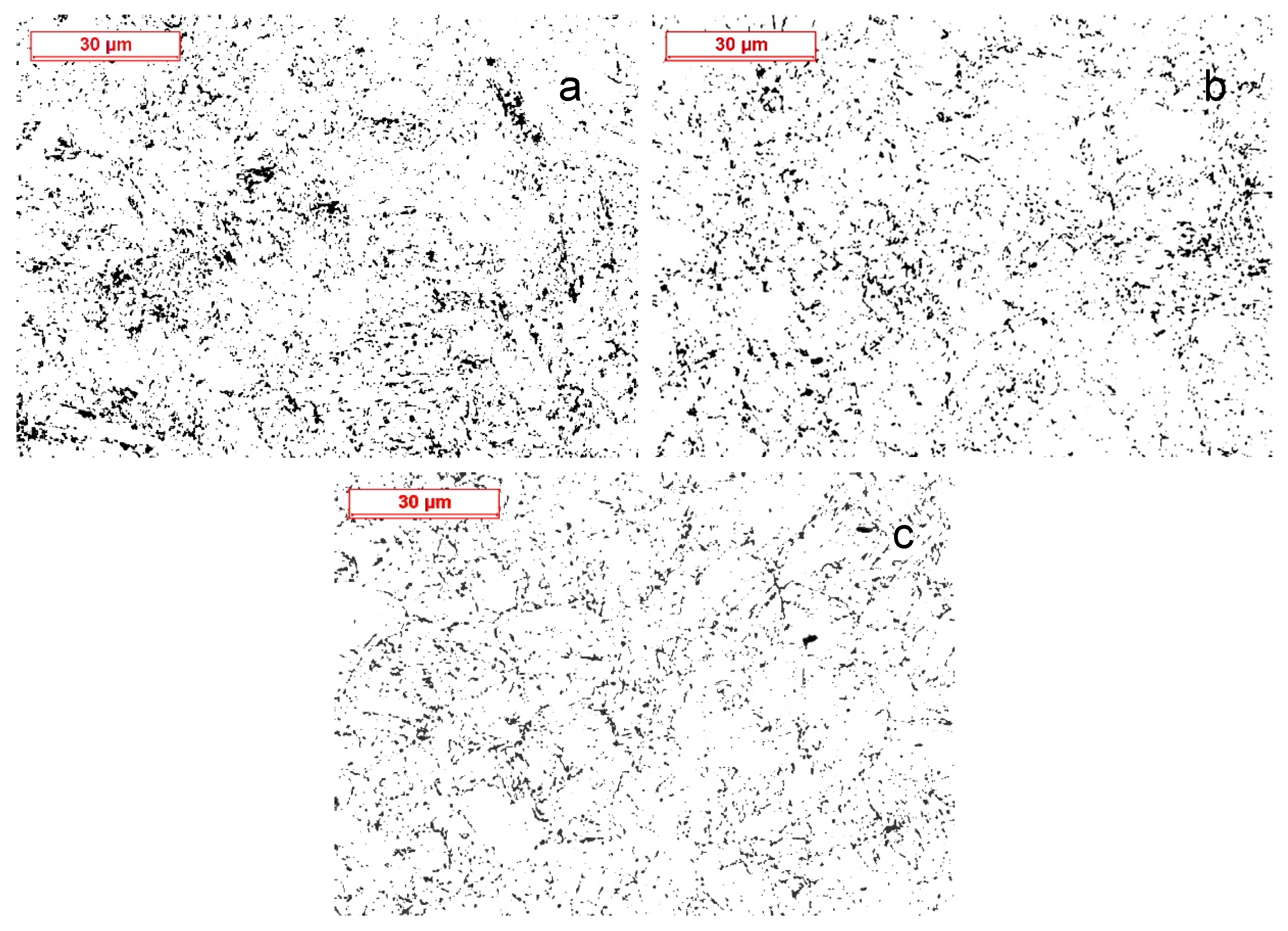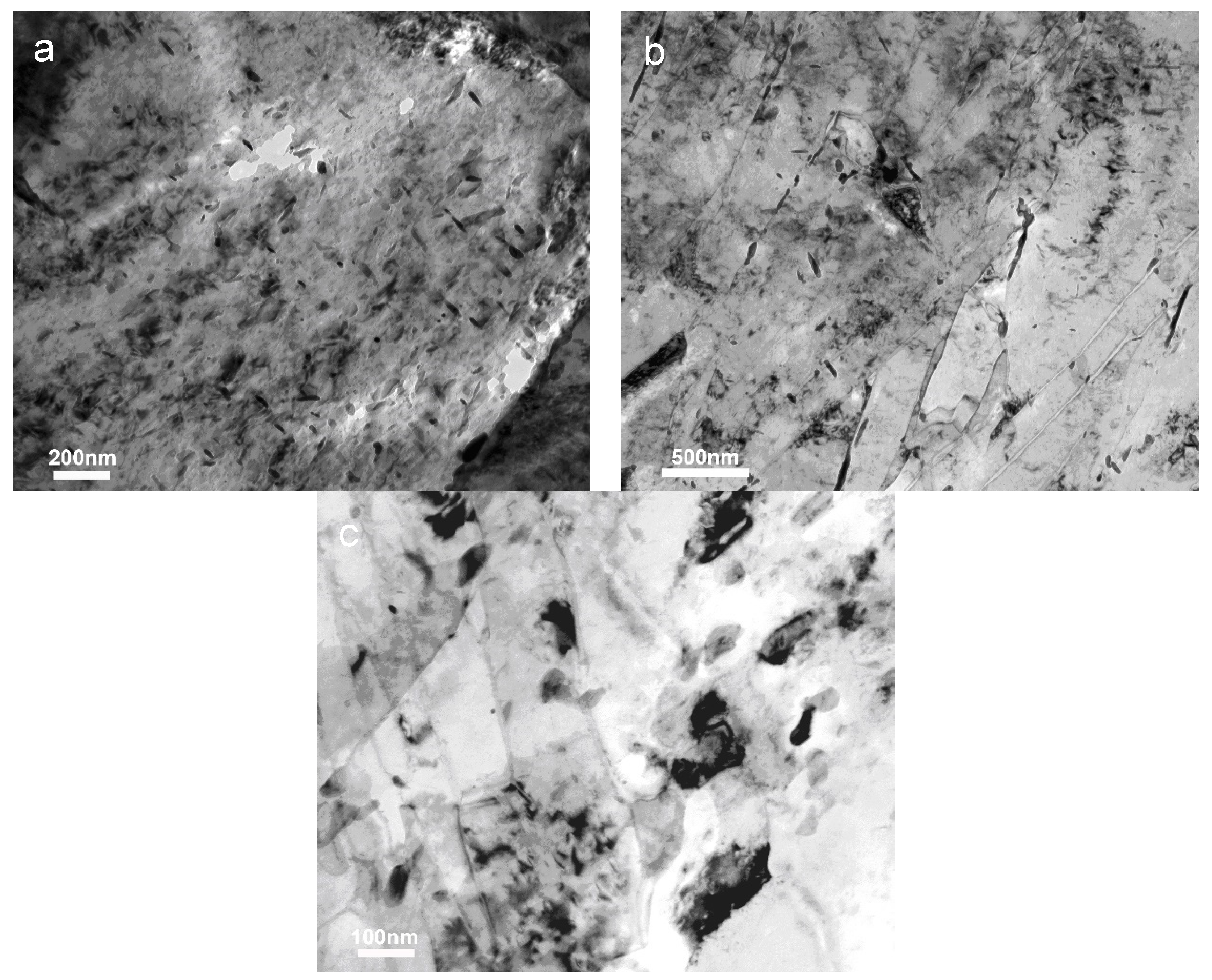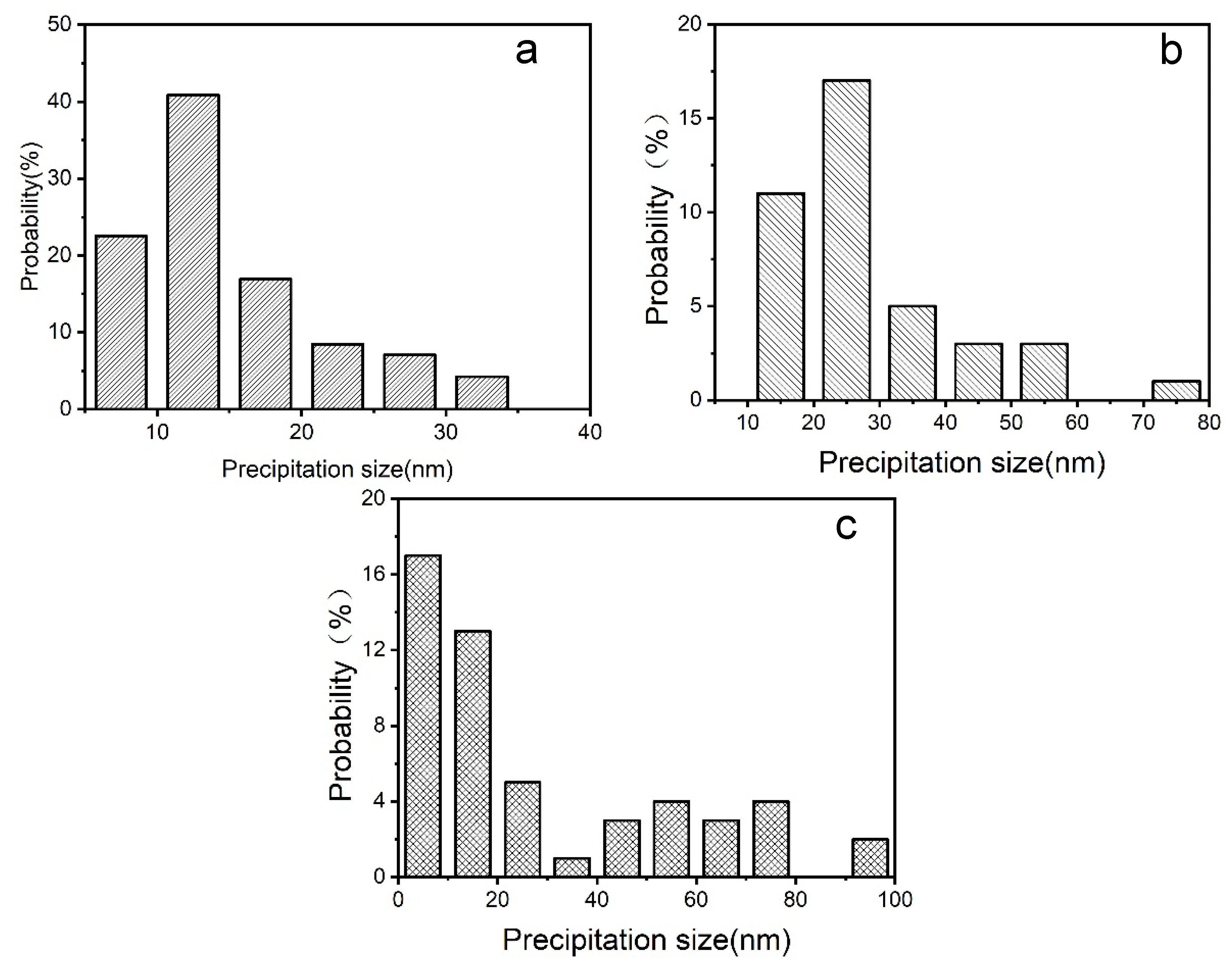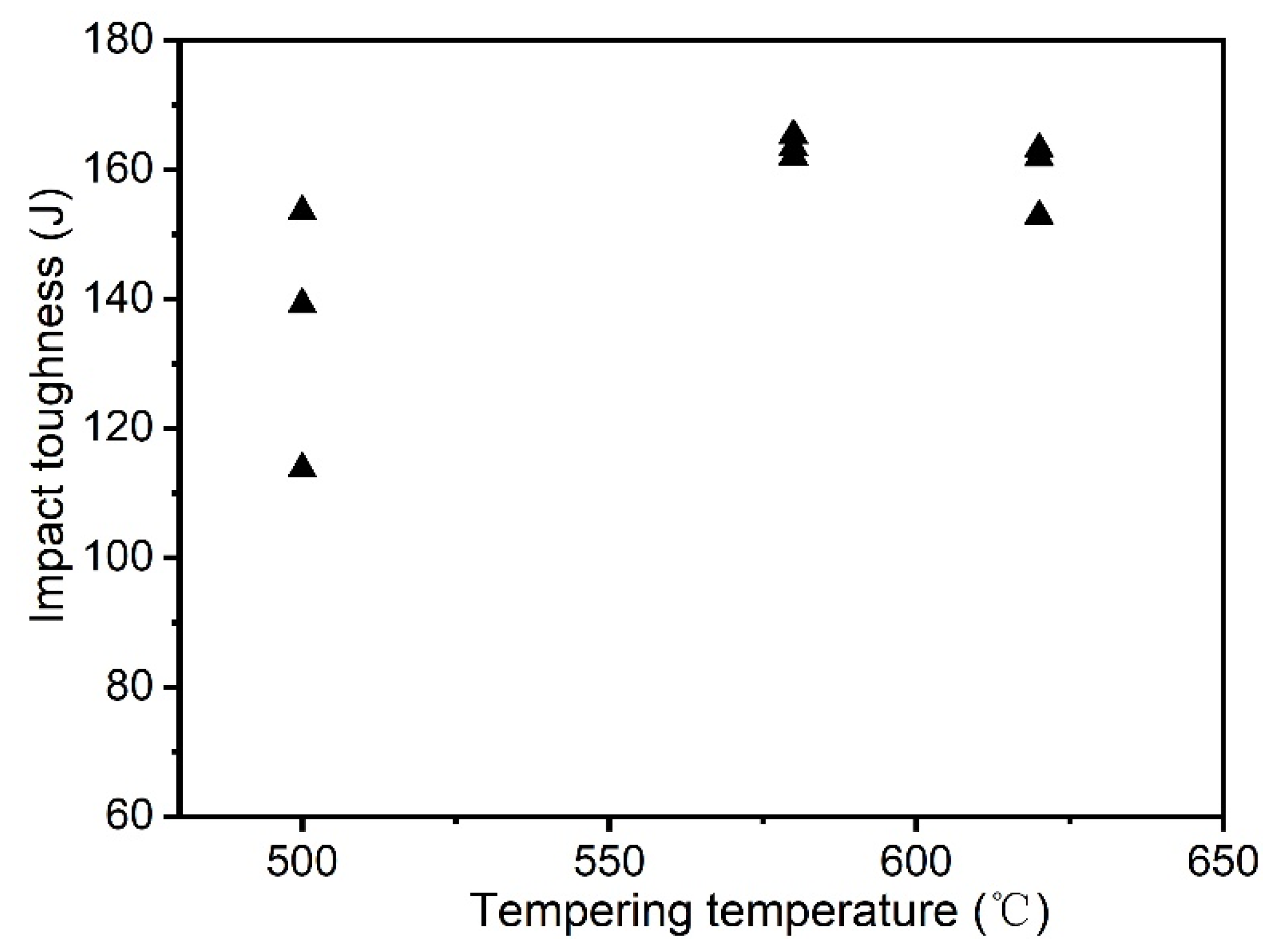1. Introduction
High-strength alloy steels are extensively used in applications such as springs, stabilizers, and ship structures due to their exceptional ability to meet specific design requirements, including high strength, impact toughness, and low ductile-to-brittle transition temperatures [
1,
2,
3,
4]. The mechanical properties and microstructures of these steels can be significantly enhanced through heat treatment processes, with tempering being one of the most critical treatments Over the past decades, extensive research has focused on the role of tempering in modifying precipitation behavior and improving the mechanical properties of steels[
5,
6,
7,
8].
Tempering involves heating the steel to a temperature below its critical point, followed by cooling, to achieve desired mechanical properties through various transformation mechanisms. These mechanisms, which involve either long-range or short-range atomic transport, can be categorized into distinct stages based on microstructural evolution. The first stage of tempering (100-200°C) involves the precipitation of ε-carbides. These carbides nucleate due to modulated structures formed during low-temperature aging, and at the end of this stage, martensite retains its tetragonality. In low-carbon steels, this stage may not be prominent due to limited ε-carbide formation[
9]. The second stage (200-300°C) is characterized by the decomposition of residual austenite into ferrite and cementite, driven by carbon diffusion in the austenite. During the third stage (200-350°C), cementite appears with a Widmanstätten distribution, characterized by a specific orientation relationship with the matrix. In the fourth stage (400-700°C), cementite particles coarsen and lose their crystallographic morphology, and martensite lath boundaries are replaced by equiaxed ferrite grain boundaries[
10,
11,
12,
13,
14].
The addition of alloying elements to steel significantly influences the tempering process. These elements can retard the growth of carbides and preserve the supersaturation of the α-solution with carbon, maintaining the state of tempered martensite up to 400-500°C. Furthermore, alloying elements can slow down recrystallization and polygonization processes, further affecting the tempering outcomes[
15,
16,
17,
18,
19,
20].
Characterizing misorientation in metals is crucial because it impacts mechanical properties at various temperatures, as well as physical properties, surface properties, and phase transformations. Misorientation analysis, now effectively performed using electron backscatter diffraction (EBSD), provides valuable insights into microstructural features[
21,
22,
23]. EBSD has become an indispensable tool in materials science, particularly for steel microstructure characterization, due to its ability to provide detailed orientation mapping at high spatial resolutions. This technique allows researchers to investigate grain boundary characteristics, phase distributions, and deformation mechanisms in a wide range of metallic materials[
24,
25,
26,
27]. One of the primary advantages of EBSD is its ability to generate orientation maps that reveal the crystallographic orientation of grains within a polycrystalline material. These maps are essential for understanding the relationships between processing conditions, microstructure, and mechanical properties. EBSD’s high sensitivity to small misorientations enables the detection of subtle changes in grain structure and the identification of low-angle grain boundaries, which are critical for predicting material performance under various loading conditions. By analyzing misorientation between lattices—expressed by rotation axes and angles—researchers can gain a comprehensive understanding of the roles of different phases in forming microstructures [
28,
29,
30]. The ability to correlate misorientation data with mechanical properties makes EBSD an essential technique for developing advanced high-strength steels with improved performance characteristics.
Although the precipitation processes during quenching and tempering in nickel alloy steels have been widely studied, detailed investigations, particularly in steels with around 4.5% nickel, remain insufficient. This study aims to investigate the influence of tempering temperature on the impact toughness of high-nickel steel. By utilizing OM, SEM, and TEM, the precipitation behavior during the tempering process is elucidated. Additionally, EBSD is employed to reveal misorientation distributions and their impact on the steel’s toughness.
3. Results and Discussions
Tempering at temperatures below the Ac1 is a critical step in heat treatment, affecting the redistribution or precipitation of carbon and alloying elements as carbides depending on the tempering temperature, which in turn enhances the mechanical properties of steels. During tempering, the dislocation density decreases, and residual stresses from quenching are relieved. This section presents the detailed results of the microstructural and mechanical property analyses performed on the high-nickel steel after tempering at various temperatures.
Figure 1 shows the SEM microstructures at various tempering temperatures.
After tempering for 2 hours, fine carbides precipitate, as observed in
Figure 3b–d for tempering temperatures of 500°C, 580°C, and 620°C, respectively. At 500°C, the microstructure shows a significant number of fine carbides distributed within the martensitic matrix, predominantly precipitating along the lath boundaries and within the laths. This distribution is critical in enhancing the steel’s hardness and wear resistance. Cementite particles precipitate within the martensite and along lath orientations, contributing to the overall hardness and stability of the microstructure.
The addition of alloying elements, such as nickel and molybdenum, significantly affects the precipitation behavior during tempering. These elements play a crucial role in stabilizing the carbides and preventing their coarsening. Notably, tempering at 580°C results in fine precipitates without significant coarsening, attributable to the segregation of alloying elements at the carbide-ferrite interface. This segregation acts as a barrier to carbon diffusion, thereby maintaining the fine precipitate size and ensuring a uniform distribution throughout the matrix. The presence of alloying elements in the cementite structure inhibits its coarsening during the fourth stage of tempering. This inhibition is particularly beneficial as it helps maintain the mechanical properties of the steel, such as toughness and hardness, over extended periods.
Although martensite lath boundaries remain stable up to approximately 620°C, considerable dislocation rearrangement occurs within the laths. This rearrangement reduces dislocation density and leads to the formation of lath-shaped ferrite grains derived from martensite, as indicated in
Figure 3d. At 620°C, the microstructure undergoes more pronounced changes. The precipitates begin to coarsen significantly, and the martensitic laths transform into equiaxed ferrite grains. This transformation is accompanied by a decrease in hardness and an increase in toughness, as the steel’s microstructure becomes more stable and less prone to brittle fracture.
Figure 4 presents the misorientation distributions after tempering at 500°C, 580°C, and 620°C. And
Figure 5 displays the misorientation angles within a single grain.
As the tempering temperature increases, low-angle boundaries decrease, as shown in
Figure 4. At 500°C, low-angle boundaries (angles less than 10°) exceed 75%, indicating a high density of dislocations and sub-grain boundaries, which contribute to the material’s strength but also to its brittleness. At 580°C, low-angle boundaries decrease to about 70%, indicating that precipitation particles lose their orientations. This reduction in low-angle boundaries is beneficial, as it leads to a more random distribution of precipitates, which enhances the mechanical properties, particularly impact toughness. The random distribution helps to interrupt crack propagation pathways, thereby increasing the material’s ability to absorb impact energy. At 620°C, low-angle boundaries further decrease, leading to coarsened precipitates as finer particles dissolve into the matrix to support the growth of larger particles.
This coarsening effect is significant as it indicates the movement and redistribution of alloying elements within the microstructure, which impacts the overall toughness and ductility of the steel.
Figure 5 shows that at 500°C, misorientation angles within a grain do not exceed 5°, suggesting a relatively uniform strain distribution within the grains. However, at 620°C, misorientation angles range from 5° to 12°, suggesting a more heterogeneous strain distribution. These higher misorientation angles absorb less energy and provide minimal resistance to crack propagation, which can lead to reduced toughness. This indicates that while tempering at higher temperatures can reduce residual stresses and dislocation densities, it can also introduce larger grain boundary misorientations that might detract from the material’s overall toughness and impact resistance.
The evolution of precipitation with increasing tempering temperature is shown in
Figure 6.
From
Figure 6 it can be seen that the number of precipitates decreases slightly as the tempering temperature rises. At 500°C, precipitates typically follow a Widmanstätten distribution, characterized by a specific crystallographic orientation. By 580°C, precipitates lose their distinct crystallographic morphology due to reduced dislocations and the onset of spheroidization, where smaller precipitates begin to dissolve into the matrix. This dissolution provides carbon and alloying elements for the selective growth of larger particles. At 620°C, this phenomenon becomes more pronounced. The increased temperature accelerates the diffusion rates of carbon and alloying elements, leading to significant coarsening of precipitates. Smaller particles dissolve, contributing to the growth of larger precipitates, which now dominate the microstructure. This coarsening results in a more homogeneous distribution throughout the matrix, which can influence the steel’s mechanical properties. The changes in precipitate size and distribution are crucial for understanding the impact of tempering temperature on the material’s performance, particularly its impact toughness and strength.
TEM images of steel after tempering are shown in
Figure 7, offering more detailed insights than SEM and OM.
Fine carbides precipitate during tempering, significantly influenced by temperature. At lower temperatures, carbides precipitate along specific orientations, as shown in
Figure 7a. At 580°C, precipitates lose their orientations (
Figure 7b), and at 620°C, they completely lose orientation (
Figure 7c), distributing along lath-shaped ferrite grain boundaries derived from martensite. Carbide nucleation sites include various boundaries, dislocations, and within grains, driven by the diffusion of carbon and alloying elements, with boundaries or dislocations providing rapid diffusion paths.
Figure 8 shows the precipitation size distribution as a function of tempering temperature. At 500°C, precipitation sizes follow a approximately normal distribution, with most precipitates smaller than 20 nm (
Figure 8a). At 580°C, the average precipitation size increases to about 25 nm without significant coarsening (
Figure 8b). However, at 620°C, a notable coarsening effect occurs, as evidenced by a marked increase in the size of the precipitates. Smaller precipitates dissolve and their material diffuses, leading to the growth of larger particles, which is indicated by a second peak in the distribution curve (
Figure 8c).
The TEM results reveal that at lower tempering temperatures, such as 500°C, the carbides precipitate predominantly along the martensite lath boundaries and within the laths themselves, forming a relatively ordered and oriented distribution. As the tempering temperature increases to 580°C, the carbides begin to lose their sharp orientation and start to distribute more randomly within the ferrite grains, as the dislocation density decreases and the carbides spheroidize. This random distribution enhances the impact toughness of the steel by reducing the stress concentration points and providing more uniform mechanical properties.
At the highest tempering temperature of 620°C, the carbides become fully spheroidized and lose their initial orientation completely. They are now predominantly located along the lath-shaped ferrite grain boundaries, indicating significant coarsening. The increased diffusion rates at this temperature facilitate the growth of larger carbide particles, as smaller particles dissolve and their material diffuses to larger particles. This coarsening effect can be seen clearly in the precipitation size distribution curves in
Figure 8, where a noticeable shift towards larger particle sizes is observed at 620°C. This redistribution and growth of carbides play a critical role in the resulting mechanical properties of the steel, such as impact toughness. Furthermore, the detailed TEM analysis underscores the complex interplay between tempering temperature and carbide evolution, emphasizing the necessity of precise temperature control during heat treatment to achieve the desired mechanical properties.
The influence of tempering temperature on the impact toughness of steel is shown in
Figure 9.
The impact toughness curve in
Figure 9 reflects the evolution of carbides with increasing tempering temperature. Impact toughness increases, peaking at 580°C, and then decreases slowly at 620°C. The scatter in impact toughness values decreases with higher tempering temperatures, indicating improved material homogeneity. At 500°C, fine precipitates are oriented, as shown in
Figure 3b, and low-angle boundaries are prevalent, as depicted in
Figure 4a and
Figure 5b. This orientation of fine precipitates and high density of low-angle boundaries contribute to moderate impact toughness at this temperature. At 580°C, the carbide orientation decreases (
Figure 3c), and the proportion of low-angle boundaries also diminishes (
Figure 4b), leading to a peak in impact toughness due to the more random distribution of precipitates and the enhanced dislocation mobility. This results in reduced dispersion in impact toughness values, indicating more consistent mechanical properties. However, at 620°C, the impact toughness drops significantly due to the coarsening of carbides (
Figure 7c). The larger, coarsened carbides provide less effective barriers to crack propagation, leading to a reduction in impact toughness. Additionally, the increase in high-angle boundaries at this temperature reduces the material’s ability to absorb impact energy, further contributing to the decrease in toughness.
4. Conclusions
This study comprehensively investigates the influence of tempering temperature on the precipitation behavior, misorientation distribution, and impact toughness of high-nickel steel. The following key conclusions can be drawn:
(1) Tempering high-nickel steel at varying temperatures significantly affects the precipitation of carbides. At 500°C, fine carbides with a Widmanstätten distribution are prevalent. As the tempering temperature increases to 580°C, the carbides lose their crystallographic morphology and exhibit reduced dislocation density and increased spheroidization. At 620°C, significant coarsening of carbides occurs, with smaller precipitates dissolving and larger particles growing, leading to a more homogenous but coarser microstructure.
(2) The study reveals that low-angle grain boundaries decrease as tempering temperature increases. At 500°C, low-angle boundaries exceed 75%, but this proportion reduces to about 70% at 580°C and further decreases at 620°C. This reduction in low-angle boundaries correlates with the randomization of precipitate orientations and the reduction in dislocation density, enhancing the steel’s impact toughness up to 580°C. However, at 620°C, the increase in high-angle boundaries and carbide coarsening negatively impacts the toughness.
(3) The impact toughness of the steel improves with tempering temperature, reaching a peak at 580°C, where the balance between fine, randomly distributed precipitates and reduced dislocation density optimizes mechanical properties. Beyond this temperature, at 620°C, the coarsening of carbides and the formation of high-angle grain boundaries diminish the impact toughness. This behavior underscores the critical importance of precise tempering temperature control to achieve the desired mechanical properties in high-nickel steels.
